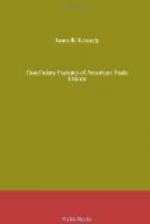While the principle that trade-union benefits are an aid in collective bargaining has not led to the development in American trade unions of those varieties which might be supposed to have an advantage in this respect, the form of some of the benefits has been shaped in accordance with this theory. Thus, there is a tendency to grade the amount of the benefit according to the length of membership, the intention being to make it more serviceable in retaining members.
In practically all the unions trade-union benefits originated with the local unions. With the introduction of national systems the unions have pursued different policies with regard to the degree of freedom allowed the local union in paying benefits. The national unions that pay benefits may thus be divided into three classes according to their relations with the local unions. In the first class are those unions that pay insurance against death and disability.[10] These unions reserve to the national union the exclusive right and authority to issue insurance but permit the local organizations to pay other benefits. In the second group are those unions that pay death, sick or out-of-work benefits from their national treasuries, but prohibit the local unions from paying similar benefits. The unions that have patterned after the Cigar Makers’ Union belong to this group. The chief of these are the Deutsch-Amerikanischen Typographia, the Iron Molders’ Union, the Journeymen Plumbers’ Association, and the Piano and Organ Workers’ Union. Finally, the largest group of unions paying benefits permit the local unions also to pay similar benefits. The principal unions of this character are the Typographical Union, the Brotherhood of Carpenters and Joiners, the Brotherhood of Painters, and the Amalgamated Wood Workers’ Union. In general, the more highly developed the beneficiary functions of the national unions become, the less freedom the local unions are given in carrying on such functions. The tendency is therefore to replace local with national benefits. The local unions still play, however, a large role in the payment of benefits. It is probable that the aggregate sum disbursed by local unions in the United States for such purposes does not fall far short of the amount expended by the national unions.
[Footnote 10: Order of Railway Conductors, Brotherhood of Locomotive Engineers, Brotherhood of Locomotive Firemen, Brotherhood of Railroad Trainmen, Order of Railroad Telegraphers, Switchmen’s Union, Brotherhood of Maintenance-of-Way Employees, and National Association of Letter Carriers.]
CHAPTER I.
INSURANCE AGAINST DEATH AND DISABILITY.




